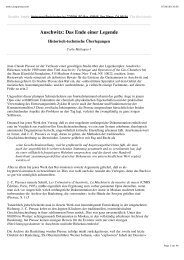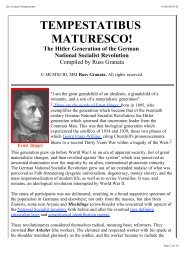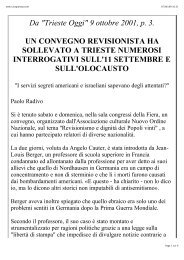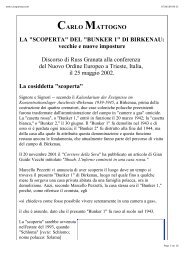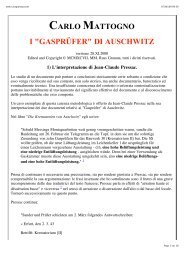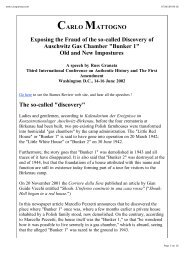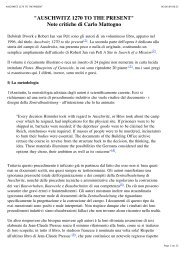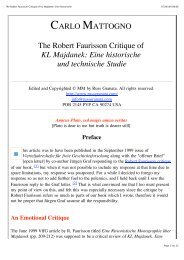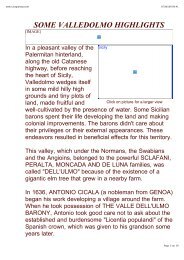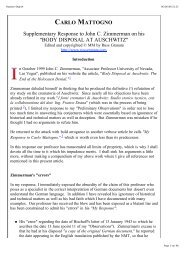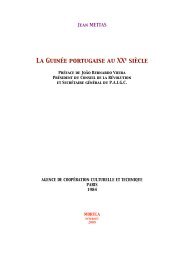Reply to Samuel Crowell's "Comments" about my "Critique ... - morula
Reply to Samuel Crowell's "Comments" about my "Critique ... - morula
Reply to Samuel Crowell's "Comments" about my "Critique ... - morula
You also want an ePaper? Increase the reach of your titles
YUMPU automatically turns print PDFs into web optimized ePapers that Google loves.
REPLY TO SAMUEL CROWELL'S "COMMENTS"<br />
06/06/09 17:18<br />
REPLY TO SAMUEL CROWELL'S "COMMENTS" ABOUT MY<br />
"CRITIQUE OF THE BOMB SHELTER THESIS"<br />
by Carlo Mat<strong>to</strong>gno<br />
Edited and copyrighted MCMXCIX Russ Granata<br />
http://www.russgranata.com/<br />
Box 2145 PVP CA 90274 USA<br />
info@russgranata.com<br />
In the first issue of Annales d'His<strong>to</strong>ire Révisionniste, a goal of revisionism is presented in this way:<br />
«Il ne prétend pas énoncer la vérité d'un fait ou événement, il prétend en vérifer l'exactitude» (it<br />
does not purport <strong>to</strong> expound the truthfulness of a fact or of an event; it purports <strong>to</strong> verify its<br />
exactness). 1<br />
I acknowledge this as an aspiring principle of <strong>my</strong> endeavors in this field, and unlike some<br />
revisionist voices which unfortunately suit very well Deborah Lipstadt's harsh invectives, I believe<br />
that the quest for exactness ought not be limited <strong>to</strong> exclusively exterminationist his<strong>to</strong>riography, but<br />
should also include revisionists as well. I therefore firmly reject the deviating concept of<br />
revisionism as being some kind of sectarian fraternity in which in-house critique is taken as a sort<br />
of betrayal or personal affront.<br />
It was from this standpoint that I wrote Leichenkeller di Birkenau: Gasschutzräume o<br />
Entwesungsräume? (English translation: Morgue Cellars of Birkenau: Gas Shelters or Disinfesting<br />
Chambers? ) which regrettably was viewed by some American revisionists as some sort of show-off,<br />
whereas the plain truth of the matter is that this writer with many years of revisionist research<br />
resulting in many publications, is no novice seeking attention and feels no need <strong>to</strong> show-off<br />
anything <strong>to</strong> anybody. Now that being stated, I shall reply <strong>to</strong> the comments of Mr. Crowell,<br />
however I have no intention of carrying on long-lasting sterile polemics, and intend <strong>to</strong> consider the<br />
question of the Crowell hypotheses concluded with this reply and let the competent reader evaluate<br />
the respective argumentation.<br />
The <strong>Samuel</strong> Crowell article entitled Comments On Mat<strong>to</strong>gno's <strong>Critique</strong> Of The Bomb Shelter Thesis<br />
is based upon mischaracterizations of the meaning of <strong>my</strong> statements and more regrettably, upon<br />
an opportunistic adaptation of his own hypotheses whereby he shifts with ease from a postulation<br />
of crema<strong>to</strong>ria designed and built as anti air-raid shelters, <strong>to</strong> one of crema<strong>to</strong>ria utilized as<br />
improvised anti-raid shelters (such as when he calls upon Nyiszli's witnessing, of which I shall later<br />
comment), as if those two postulations were not radically antithetical. My article is directed<br />
exclusively <strong>to</strong> the former postulation - specifically <strong>to</strong> the Crowell postulation that the<br />
"Leichenkeller" of Crema<strong>to</strong>ria II and III in Birkenau "tatsächlich als Leichenkeller mit einer<br />
möglichen Zusatzfunktion als Luftschutzkeller entworfen und gebaut wurden." Since according <strong>to</strong><br />
Crowell, the Pressac "criminal clues" are explained only by the "Luftschutzkeller" hypothesis, it is<br />
clear that the "Leichenkeller" must in any case have been designed as "Luftschutzkeller."<br />
<strong>Samuel</strong> Crowell begins his critique with the following comment:<br />
"But here's the remarkable thing. There is not one word <strong>about</strong> gastight doors in Signor<br />
Mat<strong>to</strong>gno's article. Not one word. Even more remarkable in his praiseworthy book on KL<br />
Majdanek, home of the no<strong>to</strong>rious "Auert" air-raid shelter door, a casting of which sits on display<br />
Page 1 sur 19
REPLY TO SAMUEL CROWELL'S "COMMENTS"<br />
06/06/09 17:18<br />
at the United States Holocaust Memorial Museum, neither Jürgen Graf nor Signor Mat<strong>to</strong>gno chose<br />
<strong>to</strong> say one word <strong>about</strong> the gas-tight doors at the camp. In a book that painstakingly provides<br />
copies of several original documents, they unaccountably forgot <strong>to</strong> include any copies of the<br />
delivery bills concerning these gas-tight doors, nor even comment on them in the text."<br />
I reply that in the study KL Majdanek: Eine his<strong>to</strong>rische und technische Studie, a book I wrote in<br />
collaboration with Jürgen Graf, the issue of delousing installation doors in the camp has not been<br />
addressed because it is absolutely irrelevant and as far as I know is important only <strong>to</strong> <strong>Samuel</strong><br />
Crowell, but since he blames me for this, I shall reply in a detailed manner <strong>to</strong> this point <strong>to</strong>o; but<br />
first of all, allow us <strong>to</strong> point out that the Crowell hypothesis is not based upon a study of the<br />
German documents, nor is it based upon a Crowell on-site study of the installations; it is based<br />
upon confrontation of two pho<strong>to</strong>graphs! Noticing that this cannot be properly defined as scientific<br />
working methodology, let us then see just what is the foundation of the Crowell hypothesis.<br />
1) The doors of the installation at issue were constructed by the firm "Auert" of Berlin. On the<br />
external side of the round peep-holes installed in the gastight doors of the Entwesungsanlage<br />
appears the writing "AUERT BERLIN." This does not therefore deal with the firm AUER of<br />
Berlin which specialized in anti-gas protection, but from another firm. These four doors presented<br />
two closing levers (Hebelverschlüsse) - one up and the other down - with an outside handle so that<br />
they could be hermetically closed only from the outside. The two doors on the north side have<br />
furthermore, a central latch (Zentralverriegelung) which likewise closes from the outside. These<br />
doors were thus built <strong>to</strong> be closed from the outside, and not from the inside, and therefore could<br />
not have been utilized for an anti-gas shelter.<br />
2) In our above-cited work, KL Majdanek: Eine his<strong>to</strong>rische und technische Studie, we have shown<br />
with reference <strong>to</strong> documents of the Zentralbauleitung in KGL Lublin (Majdanek), that the<br />
installation of the anti-gas doors at issue belonged <strong>to</strong>, were designed, and were constructed, as<br />
"Entwesungsanlage." There is no doubt whatsoever <strong>about</strong> this. Here is a his<strong>to</strong>rical summary of this<br />
installation with the following chronology:<br />
27 May 1942: Amt IIB of WVHA orders an "Entwesungsanlage" for the "Begkleidungswerk<br />
Lublin";<br />
19 June 1942: Chef des Amtes Zentrale Bauinspektion of the SS-WVHA 2 , SS-<br />
Sturmbannführer Lenzer reports <strong>to</strong> Bauinspektion der Waffen-SS und Polizei<br />
Generalgouvernment, the above-stated order "zum Bau einer Entwesungsanlage nach dem<br />
System der Blausäure-Entwesung";<br />
10 July 1942: The Leiter der Zentralbauleitung sends the Bauinspektion der Waffen-SS und<br />
Polizei Generalgouvernment, the administrative documentation on the "Entwesungsanlage";<br />
10 July 1942: The drafting of the "Erläuterungsbericht zur Errichtung einer<br />
Entwesungsanlagen für die Pelz-und Bekleidungswerkstätte Lublin";<br />
10 July 1942: The drafting of the "Kostenanschlag über Errichtung einer<br />
Entwesungsbaracke für die Pelz- und Bekleidungswerkstätte Lublin";<br />
August 1942: The preparation of the drawing "K.G.L. Lublin. Entwesungsanlage. Bauwerk<br />
XIIA";<br />
Page 2 sur 19
REPLY TO SAMUEL CROWELL'S "COMMENTS"<br />
06/06/09 17:18<br />
11 September 1942: The Zentralbauleitung orders two Heissluftapparate from the firm<br />
Theodor Klein - Maschinen-und Apparatebau Ludwigshafen Rhein, Knollstrasse 26, for the<br />
"Entwesungsanlage";<br />
22 Oc<strong>to</strong>ber 1942: On the list of completed Bauwerke is the "Erstellung einer<br />
Entwesungsanlage" for the Bauvorhaben Pelz- und Bekleidungswerkstätte Lublin.<br />
The presence of vast stains of ferric ferrocyanide on the walls of the "Entwesungskammer" show<br />
that hydrocyanic acid was used inside this installation.<br />
No document hints <strong>to</strong> a possibility that this installation could serve the dual purpose of<br />
"Entwesungsanlage" and "Luftschtzbunker." Moreover, the ceiling of the delousing installation,<br />
as per the Kostenanschlag of 10 July 1942, was then only 12 cm (4.7 inches) thick and thus<br />
unsuitable for anti air-raid purposes, and since the doors could be tightly closed only from the<br />
outside, it is clear that the "Entwesungsanlage" could not even be used as an anti-gas shelter<br />
because of its construction, therefore the Crowell hypothesis is unfounded.<br />
As <strong>to</strong> "delivery bills concerning these gastight doors", we did not include such things in our<br />
publication simply because we do not possess such documents which are not among the<br />
documentation we examined in Lublin.<br />
The Crowell reproach that in <strong>my</strong> article "there is not one word <strong>about</strong> gastight doors" is<br />
meaningless since the purpose of that article was <strong>to</strong> present the general untenableness of the<br />
Crowell hypotheses, not <strong>to</strong> discuss the meaning and the value of the Pressac "criminal signs", a<br />
task I have already done elsewhere.<br />
Then <strong>Samuel</strong> Crowell comments on <strong>my</strong> arguments [SC=<strong>Samuel</strong> Crowell, CM=Carlo Mat<strong>to</strong>gno]:<br />
SC: "ARGUMENT 1. Mat<strong>to</strong>gno argues that the argument for air raid shelters is his<strong>to</strong>rically<br />
flawed because there are no documents <strong>about</strong> air raid shelters prior <strong>to</strong> 16 November 1943. He<br />
further asserts his authority by referring <strong>to</strong> the absence of any prior or any other meaningful<br />
documents.<br />
SC: COMMENT: Signor Mat<strong>to</strong>gno is in error, both in fact and by inference. For over a year,<br />
there have been three documents pertaining <strong>to</strong> air raid shelter construction at Birkenau posted on<br />
the Internet at: http://www.fpp.co.uk and http://www.codoh.com. Two of these documents antedate<br />
the letter Mat<strong>to</strong>gno cites, and both of them makes it clear that plans for constructing air raid<br />
shelters at Birkenau were so far advanced by August of 1943 as <strong>to</strong> involve the chief architect<br />
Walter Dejaco of the Zentralbauleitung and involved the construction of hundreds of raid<br />
shelters."<br />
CM: Here, Crowell completely mischaracterizes the meaning of <strong>my</strong> argumentation. I wrote that<br />
the actual order <strong>to</strong> take Luftschutzmassnahmen at Auschwitz was given by the Camp Commander,<br />
SS-Obersturmbannführer Liebehenschel on 16 November 1943. By stating that, I did not deny the<br />
existence of documents which mention air-raid shelters prior <strong>to</strong> 16 November 1943, but rather I<br />
deny the construction of such installations at Auschwitz prior <strong>to</strong> that date. The document <strong>to</strong> which<br />
I referred, Standortbefehl Nr. 51/43 dated 16 November 1943 leaves no doubt in this regard. It<br />
says:<br />
"Luftschutzmassnahmen im Standort Auschwitz. Nach Mitteilung der vorgesetzten zuständigen<br />
Page 3 sur 19
REPLY TO SAMUEL CROWELL'S "COMMENTS"<br />
06/06/09 17:18<br />
Dienststellen sind nunmehr auch im Standortbereich Auschwitz sofort die erforderlichen<br />
Luftschutzmassnahmen in Angriff zu nehmen. Mit der Durchführung dieser Massnahmen<br />
beauftrage ich in meiner Eigenschaft als örtlicher Luftschutzleiter den SS-Untersturmführer<br />
Josten 3 als meinen ständigen Vertreten. Ich bitte sämtliche Dienststellen, SS-Untersturmführer<br />
Josten in jeder Weise zu unterstützen."<br />
(Air raid protective measures in the Auschwitz command post. According <strong>to</strong> notification by the<br />
responsible departments, necessary air-raid protective measures must also be undertaken<br />
immediately in the area of the Auschwitz command. In <strong>my</strong> position as the head of air raid<br />
protection, I am appointing SS-Untersturmführer Josten as <strong>my</strong> permanent representative <strong>to</strong> have<br />
him undertake these measures. I am asking all departments <strong>to</strong> support SS-Untersturmführer<br />
Josten in every way).<br />
The two documents Crowell cited - the Aktenvermerk dated 25 Oc<strong>to</strong>ber and the Aktenvermerk<br />
dated 05 November 1943 do not refer <strong>to</strong> construction of "Luftschutzdeckungsgräben" in<br />
Auschwitz; on the contrary, they show that a definitive decision on that matter had not yet been<br />
made ("betreffend all offen stehenden Fragen über Herstellung der L.S. Dechungsgräben"); thus<br />
the conclusion <strong>to</strong> which Crowell comes concerning these documents is <strong>to</strong>tally arbitrary.<br />
On 10 November 1943 the Bauleiter SS-Obersturmführer Jothann sent the "Kommandantur des<br />
KL Abteilung IIIa (the "Arbeitseinsatz" section) a request for additional food ("Zusatz-<br />
Verpflegung") for the "Be<strong>to</strong>n-Kolonne" with the motivation that it "hat zur Zeit dringende und<br />
schwere Arbeiten für die Anlegung von Luftzchutzgräben zu verrichten." This is the first reference<br />
in the Zentralbauleitung documents of work of this type, and in his<strong>to</strong>rical context it clearly results<br />
that these were still in preliminary prepara<strong>to</strong>ry phase. The only legitimate and irrefutable<br />
conclusion one can draw from the documents cited above is that the decision <strong>to</strong> build anti air-raid<br />
shelters at Auschwitz was taken between the end of Oc<strong>to</strong>ber and the beginning of November of<br />
1943, and was officialized as a specific construction order by the Standortbefehl of 16 November<br />
1943. The postulation of air-raid shelter construction in the crema<strong>to</strong>ria of Birkenau as early as<br />
January of 1943 4 is thus his<strong>to</strong>rically ruled out. This is confirmed by a recent study by an<br />
Auschwitz Museum his<strong>to</strong>rian, who writes:<br />
"During the years 1943 and 1944, the question of air defense and rescue operations became<br />
of special importance because of the situation at the battle fronts. This is also confirmed by<br />
the received statistical tables, KL Auschwitz II B-II/d, Blockpfleger u. Luftschutz.<br />
This tabulation is a record of the situation of the air raid protection organization as well as<br />
of the medical services of Section BIId after 22 January 1944. The highest recorded prisoner<br />
number 17828 is a proof of this.<br />
This tabulation contains the names and camp numbers of 68 prisoners who are performing<br />
the indicated duties. The connection of these two services had occurred because of pragmatic<br />
reasons. In order <strong>to</strong> fully understand the context of this tabulation, we must point out that<br />
air raid protection was organized within the camp.<br />
There is no doubt that the Commander of Concentration Camp Auschwitz I was overall<br />
responsible for this since he held the function of Commander of the Garrison as well as head<br />
of the SS operations. The complexity of his duties lead <strong>to</strong> the fact that he left the completion<br />
of the organizational and technical matters <strong>to</strong> the Assistant of the Air Protection Command,<br />
Page 4 sur 19
REPLY TO SAMUEL CROWELL'S "COMMENTS"<br />
06/06/09 17:18<br />
but he as Camp Commander, maintained supervision. In Concentration Camp Auschwitz-<br />
Birkenau, this function was already fulfilled by SS Untersturmführer (later SS-<br />
Obersturmführer) Heinrich Josten as of autumn 1943.<br />
After the establishment of an administrative department in November 1943, 5 the<br />
responsibility for these functions in a certain part of the organization was left <strong>to</strong> the various<br />
commanders.<br />
One must believe that no independent organizational structure for air raid protection in the<br />
camps was established.<br />
Inmates who functioned in the air-raid protection service in the camp were at the same time<br />
working in other Kommandos which is evidenced by the kind of compensation for the<br />
work." 6<br />
<strong>Samuel</strong> Crowell continues:<br />
"As for the inference of large scale air-raid shelter construction, in addition <strong>to</strong> the above, we have:<br />
Second, the basement of Block 11, one of the older Stammlager buildings, is explicitly referred <strong>to</strong><br />
as air raid shelter in a Nuremberg Document, [2223-PS]."<br />
CM: An example of Crowell methodology: The document in question does not come from the<br />
Auschwitz Zentralbauleitung; on the contrary, it is a collection of testimonies and prisoners'<br />
reports <strong>about</strong> various camps, including Auschwitz, which were put out in 1945 by U.S. intelligence<br />
(!) Thus for <strong>Samuel</strong> Crowell, a prisoner's testimony has the same value as a document issued by<br />
the Zentralbauleitung! Moreover, Crowell says nothing regarding the date of the alleged<br />
transformation of the Bunker in<strong>to</strong> an anti-raid shelter, which is not insignificant since his first<br />
comment was aimed at <strong>my</strong> argument <strong>about</strong> the date 16 November 1943.<br />
SC: "Third, RFSS Himmler issued a directive <strong>to</strong> all concentration camp commandants <strong>about</strong> air<br />
raid protective measures (I have seen this quoted only in terms of protecting against escapes: I<br />
have not seen the document) dated February 2, 1943. [Himmler <strong>to</strong> Glucks, Himmler Files, Folder<br />
67, National Archives"].<br />
CM: The argument is irrelevant; even if such a document ever existed, it would not whatsoever<br />
prove that "air raid shelters" were ever constructed in Auschwitz prior <strong>to</strong> 16 November 1943.<br />
SC: "Fourth, it is well known that Majdanek received shipments of air raid shelter doors the<br />
previous fall, the same time as the German authorities prioritized supplies <strong>to</strong> the Jewish<br />
inhabitants of the Warsaw ghet<strong>to</strong> for the purpose of constructing air raid shelters. [...]."<br />
CM: In the opinion of <strong>Samuel</strong> Crowell regarding Majdanek, that alleged fact is "well known" only<br />
<strong>to</strong> <strong>Samuel</strong> Crowell, and as I have explained earlier, the tale of the "air raid shelter doors" is<br />
absolutely unfounded; besides the matter is as tangential as is the one regarding Warsaw, since it<br />
does not confirm construction of air raid shelters in Auschwitz before 16 November 1943.<br />
SC: "Fifth, it is known that the "Arrest-Bunker" at Neuengamme was fitted out with ventilation<br />
and wood shutters at the same time."<br />
Page 5 sur 19
REPLY TO SAMUEL CROWELL'S "COMMENTS"<br />
06/06/09 17:18<br />
CM: That argument is irrelevant for the above reason.<br />
SC: "Sixth, the concentration camps are routinely referred <strong>to</strong> in KZ correspondence as being vital<br />
<strong>to</strong> industry, and the "Air Raid Shelter Guidelines" from 1941 specify that all new construction,<br />
especially in the war-related industries, must have air-raid shelters."<br />
CM: The argument is irrelevant for the same reason given above.<br />
<strong>Samuel</strong> Crowell triumphantly concludes:<br />
SC: "The conclusion I draw on the basis of these inferences is that there was an ongoing attempt <strong>to</strong><br />
construct air raid shelters in the concentration camps and ghet<strong>to</strong>s at least from the Fall of 1942, or<br />
<strong>to</strong> adapt existing structures with air raid shelters as a matter of course. Mat<strong>to</strong>gno can disagree<br />
with <strong>my</strong> conclusion, but it is meaningless <strong>to</strong> do so without confronting the inferences. Finally, the<br />
assertion that there were no air raid provisions made before November 1943 is refuted by<br />
documents that have long been available on the Internet."<br />
CM: The Crowell conclusion is more ludicrous that the Crowell hypothesis: I maintain that no air<br />
raid shelter was constructed in KL Auschwitz before 16 November 1943, while Crowell claims <strong>to</strong><br />
disprove this by declaring that before that date air raid shelters had been planned or constructed<br />
elsewhere, or that general directives existed for the construction of shelters; things which I have<br />
never denied!<br />
CM: My reply <strong>to</strong> the Crowell allegation that Mat<strong>to</strong>gno "asserts his authority by referring <strong>to</strong> the<br />
absence of any prior or any other meaningful documents" is that due <strong>to</strong> his rather limited<br />
knowledge of the Auschwitz Zentralbauleitung documentation, <strong>Samuel</strong> Crowell obviously does not<br />
know of the existence of a series of monthly reports of that office (particularly the<br />
"Baufristenplan" and the "Baubericht") which describe month per month the status of the<br />
construction jobs of the Auschwitz and Birkenau camps, listing also all the existing Bauwerke. 7 In<br />
these reports (which were kept until the end of September 1943 and which also report regularly<br />
<strong>about</strong> Birkenau crema<strong>to</strong>ria), there is no indication whatsoever of any work <strong>to</strong> construct anti air<br />
raid shelters: neither inside nor outside the crema<strong>to</strong>ria. Crowell also ignores the existence of<br />
various cost estimates for Auschwitz and Birkenau camps in which are listed all the scheduled<br />
Bauwerke. Not even these documents show any trace of air raid shelters. In particular, I refer <strong>to</strong><br />
the one of 28 Oc<strong>to</strong>ber 1942, 8 which for chronological reasons aught <strong>to</strong> contain at least some<br />
indication of a "Luftschutzbunker" allegedly planned for Birkenau crema<strong>to</strong>ria.<br />
Summarily: Before 16 November 1943, neither the projects nor the reports concerning the<br />
construction pertaining <strong>to</strong> the camp, contain anything <strong>about</strong> plans or construction of air raid<br />
shelters, and if <strong>Samuel</strong> Crowell does not trust <strong>my</strong> "authority" let him go <strong>to</strong> Moscow as I have done<br />
and examine the documents.<br />
SC: "Argument 2. Parenthetically, Mat<strong>to</strong>gno refers <strong>to</strong> a visit <strong>to</strong> Auschwitz by Oswald Pohl where a<br />
number of construction projects were approved, including the construction of 15 1-man<br />
"Splitterbunker." Mat<strong>to</strong>gno claims that it does not appear that these projects were ever carried<br />
out.<br />
SC: COMMENT: One can see pictures of the 1-man "Splitterbunker" on the Nizkor site, where<br />
they have resided for over a year."<br />
Page 6 sur 19
REPLY TO SAMUEL CROWELL'S "COMMENTS"<br />
06/06/09 17:18<br />
CM: I wrote in this regard that it turns out that these projects were never carried out because the<br />
list of Bauwerke following the visit of Pohl does not mention them. I do not know the "pictures" of<br />
which <strong>Samuel</strong> Crowell writes, and cannot judge if they realistically pertain <strong>to</strong> these installations in<br />
Auschwitz-Birkenau. The question is marginal because we are dealing with installations which<br />
refer <strong>to</strong> 1944.<br />
SC: "ARGUMENT 3. Mat<strong>to</strong>gno calls the claim that there were numerous "Splitterbunker" for the<br />
prisoners "shaky."<br />
SC: COMMENT: This ignores the fact that the anonymous individual who forwarded the three<br />
documents cited above assures VffG that his elder relative constructed these, meanwhile, the Allied<br />
raid of August 1944, killed 50 workers in one of these "trench shelters", so it is clear that they were<br />
built."<br />
CM: For lack of documents, Crowell supports his argument with a second-hand testimony of an<br />
anonymous person! - therefore this is not serious. On the other hand, not ever having set a foot in<br />
Birkenau, Crowell necessarily ignores that in front of the barracks there is no trace of<br />
"Splitterbunker" for the prisoners - where have they gone?<br />
SC: "ARGUMENT 4. Mat<strong>to</strong>gno argues that the basement morgues in the crema<strong>to</strong>ria would never<br />
have been designed as air raid shelters because otherwise there would exist many documents <strong>about</strong><br />
this, and he hasn't seen any.<br />
SC: COMMENT: There are two problems with this argument, the first being that Mat<strong>to</strong>gno's<br />
authority <strong>to</strong> speak of the existence or non-existence of relevant documents was exploded in<br />
Argument 1. The second, more fundamental argument, is that he doesn't seem <strong>to</strong> appreciate that<br />
the adaptation of any given space - and particularly basements - <strong>to</strong> serve in a supplemental<br />
capacity as air raid shelters does not require much in the way of adaptation, except some<br />
rudimentary modifications such as gastight doors with peepholes."<br />
CM: As I have shown, since Crowell argument number one is completely unfounded even if we<br />
reject <strong>my</strong> "authority." <strong>Samuel</strong> Crowell presents this as though I speak ex cathedra, and I do not.<br />
My statements are specifically documented and cited among the notes in the published study of the<br />
Zentralbauleitung, and since I have personally examined all the documents of the Auschwitz<br />
Zentralbauleitung preserved in Moscow (some 88,200 pages), it will be granted me <strong>to</strong> have<br />
acquired a somewhat different view of this subject than that of individuals such as <strong>Samuel</strong> Crowell<br />
who know some tens of second-hand documents. About this specific problem, a vast documentation<br />
exists <strong>about</strong> Birkenau crema<strong>to</strong>ria, a great part of which is published by Pressac. Other than the<br />
plans and maps, accurate inven<strong>to</strong>ries ("übergabeverhandlung") and account books<br />
("Bauausgabebuch" for Crema<strong>to</strong>ry III) also exist. The possible planning of air raid shelters in the<br />
"Leichenkeller" of the crema<strong>to</strong>ria, since they would have occupied the same space, would have<br />
inevitably left some traces among this massive accumulation of documents, as happened for<br />
Crema<strong>to</strong>ry I, whose transformation <strong>to</strong> a "Luftschutzbunker für SS-Revier mit einem<br />
Operationsraum" is documented by the well-known plan of 21 September 1944, and furthermore<br />
by an "Erläuterungsbericht" and a "Kostenüberschlag" both dated 02 November 1944. In the<br />
documentation concerning the crema<strong>to</strong>ria in Birkenau, there is no trace of planning or<br />
construction of air raid shelters in the "Leichenkeller", and that shows that the Crowell hypothesis<br />
is documentarily unfounded.<br />
SC: ARGUMENT 5. Mat<strong>to</strong>gno argues that air raid shelter provisions must have figured in the<br />
transfer documents for the crema<strong>to</strong>ria.<br />
Page 7 sur 19
REPLY TO SAMUEL CROWELL'S "COMMENTS"<br />
06/06/09 17:18<br />
SC: COMMENT: Once again, Mat<strong>to</strong>gno presumes that the fitting out of a space as an air raid<br />
shelter is going <strong>to</strong> follow fixed and rigid guidelines. Yet, as the literature which I have quoted<br />
extensively in <strong>my</strong> articles makes clear, this is by no means the case. The only way in which air raid<br />
shelter provisions HAD <strong>to</strong> be described in terms of the transfer documents would be if their<br />
inclusion was essential <strong>to</strong> the operation of the crema<strong>to</strong>ria. But no one has ever made that<br />
argument. Furthermore, many of the "criminal traces" refer <strong>to</strong> dates subsequent <strong>to</strong> the transfer<br />
documents."<br />
CM: <strong>Samuel</strong> Crowell, not sure of his hypothesis, adjusts it <strong>to</strong> circumstances via an opportunistic<br />
methodology - when he opposes his hypothesis <strong>to</strong> Pressac, he speaks of an air raid shelter as an<br />
organic center, well-organized with "Luftschutzräume, Dekontaminationszentren", 9 and even<br />
"einen Keller der zur Aufnahme von Gasverletzen gedacht ist"; 10 but when he needs <strong>to</strong> justify his<br />
hypothesis, his air raid shelter becomes even rudimentary. He uses this duplicity <strong>to</strong> evade a<br />
fundamental problem, which is that if the air raid shelter feature in the "Leichenkeller" is the<br />
result of a project designed <strong>to</strong> create mortuary rooms which could also be used as air raid shelters,<br />
then we expect that these shelters are conforming <strong>to</strong> the shelters described in the technical<br />
literature which I have cited, exactly as if a crema<strong>to</strong>rium is projected as a crema<strong>to</strong>rium, we expect<br />
that it be properly equipped - with a crema<strong>to</strong>ry oven, a mortuary room, and a dissection room. So<br />
if the equipment of air raid shelters does not appear at all in the "übergabeverhandlung" of the<br />
crema<strong>to</strong>ria, then they (their "Leichenkeller") were also not projected as gas tight bomb shelters.<br />
SC: "ARGUMENT 6. Mat<strong>to</strong>gno argues that "undressing rooms" were not equipped with gastight<br />
doors.<br />
SC: COMMENT: Since an undressing room's function is for the shedding of contaminated<br />
clothing, it is not clear why such a room would require gas-tightness in any case."<br />
CM: Perhaps that would be true in the hypothesis of an improvised "Luftschutzbunker", but not<br />
in the case of an installation well-articulated with "Luftschutzräume", "Engiftungsanstalt",<br />
"Dekontaminationszentrum" - a refuge from gas poisoning that would have required the entire<br />
"Kellergeschoss" of the crema<strong>to</strong>ria, and therefore the hermetic sealing of all its openings.<br />
SC: "ARGUMENT 7. Mat<strong>to</strong>gno argues that the morgue's ventilation capacity was inadequate for<br />
an air raid shelter.<br />
SC: COMMENT: Once again, Mat<strong>to</strong>gno ignores the data in the literature which discusses<br />
provisions for air raid shelter use with and without ventilation systems."<br />
CM: Here again, Crowell plays on the ambiguity of the organic, well-equipped air raid shelter,<br />
and the rudimentary shelter. According <strong>to</strong> the technical literature I presented, a gastight bomb<br />
shelter by definition, is an installation equipped with ventilation facilities, filtering and air<br />
regeneration devices, etc. Otherwise we are confronted with a simple improvised refuge, which<br />
however, cannot in any way justify or explain away the Pressac "criminal indications."<br />
SC: "ARGUMENT 8. Mat<strong>to</strong>gno corrects the calculation of the capacity of the morgue at 4,800<br />
cbm per hour, as opposed <strong>to</strong> twice that capacity that I cited from Pressac.<br />
SC: COMMENT: Assuming that this is true, that still would not invalidate the use of the space as<br />
an air raid shelter, it simply means that fewer people could use it and for a shorter period of<br />
Page 8 sur 19
REPLY TO SAMUEL CROWELL'S "COMMENTS"<br />
06/06/09 17:18<br />
time."<br />
CM: There is no need <strong>to</strong> "assume" that fact, it is enough <strong>to</strong> read the documents reproduced on<br />
pages 110 and 112 of <strong>my</strong> work Auschwitz: The End of a Legend (Institute for His<strong>to</strong>rical Review). As<br />
<strong>to</strong> the use of Leichenkeller" as bomb shelters, <strong>Samuel</strong> Crowell uses the above mischaracterization<br />
once again. Here I need <strong>to</strong> clarify an essential point. Crowell attributes <strong>to</strong> me the "conclusion that<br />
the crema<strong>to</strong>ria could never have functioned as air raid shelters" which is true if referred <strong>to</strong><br />
standard shelters, but is false if referred <strong>to</strong> improvised refuges. That the "Leichenkeller" of the<br />
crema<strong>to</strong>ria could have been used as improvised "Luftschutzbunker" is obvious, and that would<br />
have also been possible for a brief time without mechanical ventilation, but that does not have<br />
anything <strong>to</strong> do with the planning of "Luftschutzbunker" in the "Leichenkeller", because only this<br />
matter could give <strong>Samuel</strong> Crowell the illusion of being able <strong>to</strong> explain Pressac's "criminal<br />
indications."<br />
SC: "ARGUMENT 9. Mat<strong>to</strong>gno corrects <strong>my</strong> calculation of the morgue's volume, it was 499 cubic<br />
meters versus 525 as I roughly calculated.<br />
SC: COMMENT: To be sure, forgetting <strong>to</strong> account for the volume occupied by the concrete<br />
columns in the morgue was a serious omission insofar as it allowed for an error of 5% in <strong>my</strong><br />
calculation. This might be profitably compared <strong>to</strong> the 50% error in Mat<strong>to</strong>gno's remarks by<br />
forgetting <strong>to</strong> address the issue of gastight doors with peepholes."<br />
CM: This remark displays an attitude which can not <strong>to</strong>lerate being corrected - not even regarding<br />
absolutely certain data; here Crowell refers <strong>to</strong> an observation of mine - one written in an end note<br />
(!) and quite marginally, <strong>to</strong> show the reader in an "argument", the exact data on the ventilation<br />
problem! As <strong>to</strong> <strong>my</strong> alleged "50% error" I will return below.<br />
SC: "SUMMARY OF ARGUMENTS 7, 8, 9: The volume of the morgue was 499 cubic meters. The<br />
rule of thumb is 1,5 meters per person per hour. This means that this morgue would still offer 2.5<br />
hours air raid and gas protection even with no operating ventilation system for 200 people."<br />
CM: Here again Crowell counters a claim I never made; I never denied that the "Leichenkeller"<br />
could have been used as improvised "Luftschutzbunker"; what I deny is that they were projected<br />
and also constructed as normal "Luftschutzbunker" - moreover, with this calculation, <strong>Samuel</strong><br />
Crowell presents more evidence of his competence level in this field. According <strong>to</strong> the specialized<br />
literature, for the calculation of the staying time and the number of people in a "Luftschutzraum"<br />
in relation <strong>to</strong> the function of time and volume, the following formulae are used: (they also take in<strong>to</strong><br />
account the amount of carbon dioxide eliminated by each person in the breathing process):<br />
v<br />
t = 0,48 ________<br />
n<br />
v<br />
and t = 0,48 ________<br />
t<br />
with:<br />
v = capacity of the "Luftschutzbunker" in m 3<br />
n = number of the occupants<br />
t = length of stay in hours. 11<br />
Page 9 sur 19
REPLY TO SAMUEL CROWELL'S "COMMENTS"<br />
06/06/09 17:18<br />
Besides, "the highest cubic volume of the occupants (75 dm 3 per person) plus that of the existing<br />
material should be subtracted from the capacity of the shelter in cubic meters." 12 Therefore from<br />
the theoretical 499 m 3 should be subtracted (200 × 0,075 =) 15 m 3 , so the real volume would be<br />
(499 - 15=) 484 m 3 .<br />
It follows that 200 people would have been able <strong>to</strong> stay in a "Leichenkeller" for 0.48 × 484 ÷ 200 =<br />
1.16 hours (<strong>about</strong> 64 minutes).<br />
Why <strong>Samuel</strong> Crowell chose 200 people in his example? Just for mere matter of convenience. If in<br />
fact the number of refugees were for instance 800, the staying time would get down <strong>to</strong> 16 minutes;<br />
if they were 1,200, the time would be 11 minutes. With the Crowell hypothesis, the ideal numbers<br />
would have been the highest, because at the beginning, before the alleged construction of<br />
"Luftschutzdeckungsgräben" for the prisoners (that did not take place before 16 November 1943),<br />
the "Luftschutzbunker" of the crema<strong>to</strong>ria would have served for the camp prisoners as well,<br />
whose numbers were definitely abundant.<br />
SC: "ARGUMENT 10. Mat<strong>to</strong>gno makes three points <strong>about</strong> the ventilation system: (a) a filtration<br />
system places a load on the air conditioning system, (b) two separate systems are required, (c) the<br />
need <strong>to</strong> install the ventilation system in the bunker itself.<br />
SC: COMMENT: They are good points and I tip <strong>my</strong> hat <strong>to</strong> Signor Mat<strong>to</strong>gno here. However, they<br />
are not decisive. First, point (a) rests on an Italian configuration for ventilation systems, which has<br />
nothing <strong>to</strong> do with German "Schutzraumbelufter." Second, two separate systems are required:<br />
only under ideal conditions, otherwise greater or lesser levels of "Behelfsmässigkeit" (do it<br />
yourself-ness) are called for, as is noted continually in the literature quoted in <strong>my</strong> article. Finally,<br />
that the ventilation system was not connected <strong>to</strong> the morgue does not mean that a single bomb<br />
would suffocate the inhabitants of the morgue, it simply means that they would not be able <strong>to</strong> get<br />
air from it in the event of a direct hit on their ventilation system, a common enough situation<br />
confronted by, and dealt with by, the inhabitants of cities like Dresden and Hamburg."<br />
CM: Once more <strong>Samuel</strong> Crowell plays with the ambiguity reported earlier - when he needs <strong>to</strong><br />
explain Pressac's "criminal indications", his "Luftschutzbunker" is an "ideal" one, equipped with<br />
"Luftschutzraum", "Entgiftungsanstalt", "Dekontaminationszentrum", "Aufnahme von<br />
Gasverletzen" etc.; but when he needs <strong>to</strong> explain the technical difficulties which such a<br />
construction presents, he becomes "behelfsmässig." Regarding point (c), it is true that in case of<br />
interruption of the ventilation system, the people inside the "Leichenkeller" would have breathed<br />
the local air, but the staying time, as I explained above, would have been reduced by the number of<br />
persons, and in case of major nervousness, would have been a few minutes.<br />
SC: "ARGUMENT 11. Mat<strong>to</strong>gno argues that the presence of corpses would make the use of these<br />
space air raid shelters impossible.<br />
SC: COMMENT: Presence of corpses would make the use of these spaces unsatisfac<strong>to</strong>ry for air<br />
raid shelters, the presence of corpses would make the use of these spaces equally unsatisfac<strong>to</strong>ry for<br />
sanitizing incoming inmates as Mat<strong>to</strong>gno will ultimately argue. However, Mat<strong>to</strong>gno ignores<br />
survivor evidence that indicates that prisoners were indeed taken <strong>to</strong> basements during air raids<br />
and moreover, according <strong>to</strong> Nyiszli, directly <strong>to</strong> the morgue in question. Indeed, Nyiszli specifies<br />
that the crema<strong>to</strong>rium II Sonderkommando, 200 strong, <strong>to</strong>ok refuge in the "gas chamber" during<br />
air raids."<br />
Page 10 sur 19
REPLY TO SAMUEL CROWELL'S "COMMENTS"<br />
06/06/09 17:18<br />
CM: Here again <strong>Samuel</strong> Crowell misrepresents <strong>my</strong> thesis which has nothing <strong>to</strong> do with "sanitizing<br />
incoming inmates." When I refer <strong>to</strong> "Entwesungsräume" I mean disinfestation chambers used for<br />
prisoners' clothing, not rooms for the sanitary treatment of new prisoners. I also point out that I<br />
have not written that the use of mortuary rooms as bomb shelters is impossible, but that the<br />
prospect of being closed for hours inside a gas tight room <strong>to</strong>gether with miasmic or infected<br />
corpses is not very inviting. And I do not believe that <strong>Samuel</strong> Crowell thinks so either, but<br />
<strong>Crowell's</strong> objection is decidedly puerile: since air raids were occurring with little warning, and the<br />
"Leichenkeller" could be full of miasmic or infected corpses, the use of the "Leichenkeller" as<br />
disinfestation chambers could be quietly programmed by the Standortverwaltung; for instance<br />
moving dead bodies in<strong>to</strong> other crema<strong>to</strong>ria.<br />
Appealing <strong>to</strong> testimonies is pathetic, demonstrating a deficiency in the application of revisionist<br />
methodology, if not a deficient understanding of revisionism itself. Serious revisionists cannot<br />
accept the use of opportunistic testimonies: why must we believe Nyiszli when he tells us that<br />
during air raids, members of the Sonderkommando sheltered themselves inside the "gas chamber"<br />
but we don't have <strong>to</strong> believe Nyiszli when he tells us that in these gas chambers people were<br />
[murderously] gassed - and I summarily point out once more that Crowell hits a false target,<br />
improvised by himself, as though I ever proclaimed the impossibility of the use of a<br />
"Leichenkeller" as an impromptu "Luftschutzbunker."<br />
SC: "ARGUMENT 12. Mat<strong>to</strong>gno argues that "Vergasungekeller" does not mean a "cellar for<br />
treating those who have been gassed."<br />
SC: COMMENT: On this point, and in light of the two documents he has put forward, I agree<br />
with him if he had read <strong>my</strong> other writings, particularly Defending Against the Allied Bombing<br />
Campaign and The Gas Chambers of Sherlock Holmes. In those places I have argued that<br />
"Vergasungskeller" would most normally refer <strong>to</strong> a "fumigation cellar" or, by extension, a<br />
"disinfection cellar", and I further point out that it was common for the Germans in World War<br />
II <strong>to</strong> adapt existing bathing and delousing establishments <strong>to</strong> double as gastight air raid shelters<br />
and gas warfare decontamination centers. This is what I mean when I say the entire premise <strong>to</strong> his<br />
argument is fallacious."<br />
CM: My article refers exclusively <strong>to</strong> the <strong>Samuel</strong> Crowell article published in VffG December 1997.<br />
SC: "ARGUMENT 13. Mat<strong>to</strong>gno argues that the "Gasskammern" in Crema<strong>to</strong>ry IV and V could<br />
not have served as aboveground gas air raid shelters because a direct hit would have killed<br />
everyone.<br />
SC: COMMENT: Obviously, a direct hit on most shelters by most bombs will kill everyone, just as<br />
a direct hit on a trench shelter in August 1944 killed everyone in that shelter. That does not mean<br />
however that during an air raid one should go running around the camp naked. Furthermore,<br />
Mat<strong>to</strong>gno ignores the sizable evidence for above ground air raid shelters, for do-it-yourself<br />
shelters, as well as the reference <strong>to</strong> the numerous red lamps for these two crema<strong>to</strong>ria which make<br />
no sense EXCEPT in the context of air raid darkening."<br />
CM: Once more Crowell creates a false objective only <strong>to</strong> triumphantly counter it. Actually, I<br />
quoted a technical piece of text which refers specifically <strong>to</strong> a "direct hit." It is not so "obvious"<br />
that a bomb striking the roof of a "Luftschutzbunker" would kill all of its occupants: if the roof is<br />
made of reinforced concrete and is sufficiently thick - 80 cm according <strong>to</strong> the Attilio Izzo study -<br />
the shelter can hold out against a middle weight bomb falling from a normal bombing height<br />
(naturally in reference <strong>to</strong> the bombs in use during the Second World War). How can we seriously<br />
Page 11 sur 19
REPLY TO SAMUEL CROWELL'S "COMMENTS"<br />
06/06/09 17:18<br />
believe that Zentralbauleitung engineers planned and also installed an "air raid shelter" in<br />
Crema<strong>to</strong>ries IV and V, which had 25 cm thin walls and quite ordinary covering? A falling bomb on<br />
those crema<strong>to</strong>ries would have destroyed the roof and caused casualties without even exploding.<br />
The objection that there existed "above ground air raid shelters" is absolutely irrelevant; I have<br />
never denied that. Why does Crowell not say anything of their structure? (I am certain that they<br />
did not have a "Heraklitplatten" roof - something which in Italy would be used <strong>to</strong> cover<br />
henhouses). In confirmation of that, I can add the fact that when Crema<strong>to</strong>ry I was transformed <strong>to</strong><br />
"Luftschutzbunker" there immediately was added "eine Verstarkung von 38cm" of the walls. 13<br />
SC: "ARGUMENT 14. Mat<strong>to</strong>gno contends that "Drahtnetz-einschiebvorrichtung" and<br />
"Holzblenden" for Crema<strong>to</strong>ria II could not have had anything <strong>to</strong> do with covering openings in an<br />
air shelter context because there were no such openings.<br />
SC: COMMENT: Aside from the fact that the absence of document describing these four opening<br />
does not prove their non-existence, it would be helpful at this point if Signor Mat<strong>to</strong>gno explained<br />
what these materials were for. The normal meaning of "Blende" is of a (vertical) shutter for an<br />
opening. The screens seem <strong>to</strong> have had an associated function. It seems likely that there where four<br />
openings - somewhere - for which these screens and shutters were designed. Otherwise why are<br />
they on the list? One thing is certain: wooden shutters and wire mesh screens are not common<br />
paraphernalia for delousing or disinfection chambers of any kind, although they are common for<br />
air raid shelters. As in many other places, Mat<strong>to</strong>gno offers destructive criticism, but no<br />
constructive explanation."<br />
CM: Unlike some others, I do not presume <strong>to</strong> know everything and <strong>to</strong> be able <strong>to</strong> explain<br />
everything; <strong>my</strong> explanations concerning <strong>my</strong> hypotheses are based upon the documents, and as <strong>to</strong><br />
the case in question, I know of no document in reference <strong>to</strong> Auschwitz containing the terms<br />
"Drahtnetzeinshiebvorrichtung" and "Holzblenden," therefore up <strong>to</strong> this moment at which I write,<br />
I am not able <strong>to</strong> explain what these were; but one thing is certain - <strong>to</strong> expect <strong>to</strong> explain via a<br />
dictionary basis, is simply frivolous - as for one example of a dictionary-based explanation, a<br />
transla<strong>to</strong>r explained the expression of R. Höss "fünf 3-Kammer-öfen" (five 3-muffeled crema<strong>to</strong>ry<br />
ovens) as "five ovens of three rooms"! Crowell keeps silent <strong>about</strong> the fact that these devices,<br />
according <strong>to</strong> the document in which they are mentioned, refer <strong>to</strong> "Leichenkeller 2", which in his<br />
opinion did not need a gas-proof door (see argument 6) since it was merely a disrobing room; but<br />
then why did it now require these gas-tight devices? What was their use? And why did they not<br />
also exist in "Leichenkeller 1" which, nevertheless, had precisely one such gas-proof door? The<br />
lack of documents demonstrating the existence of openings in the ceiling of "Leikenkeller 2" do<br />
not prove their non-existence exactly as the non-existence of documents demonstrating that<br />
<strong>Samuel</strong> Crowell has eaten babies does not prove that he has not eaten them.<br />
The truth of the accusation of "destructive criticism" is measured by the fact that Crowell himself<br />
devotes the conclusive part of his article <strong>to</strong> "Mat<strong>to</strong>gno's Positive Contribution"! Naturally, faced<br />
with such duplicity, one needs <strong>to</strong> be necessarily destructive.<br />
SC: "ARGUMENT 15. Mat<strong>to</strong>gno argues that the "Fenstergitter" are not screens but rather<br />
"Gitterfenster", that is, not screens but iron bars.<br />
SC: COMMENT: Whether Crema<strong>to</strong>ria IV and V were equipped with screens, or with bars, or<br />
with grill-work, is not really relevant. What is more relevant is that the "little doors" for these two<br />
crema<strong>to</strong>ria are identical in design <strong>to</strong> gastight Blende for air raid shelters and second, that gastight<br />
Page 12 sur 19
REPLY TO SAMUEL CROWELL'S "COMMENTS"<br />
06/06/09 17:18<br />
Blende are not part of the normal equipment for disinfection chambers. Furthermore, the number<br />
and the measures of the bars and/or screens he cited do not compare <strong>to</strong> the number and the<br />
measures of document I cited. It is therefore not obvious that "Fenstergitter" were "Eisengitter"<br />
in the first place."<br />
CM: <strong>Samuel</strong> Crowell in his article maintains that «die Auschwitzer Auftragsnummer-Nr. 353 vom<br />
27. April 1943 enthält folgende Bestellung: "12 Stücke Fenstergitter 50 x 70 cm", was allgemein als<br />
Drahtnetzgitter für jene 12 gasdichten Fenster (oder Türen) angesehen wird, die wir oben als<br />
identisch mit den Blenden und Holzblenden festgehalten hatten». He claims that Fenstergitter is<br />
synonymous with Drahtnetzgitter without giving any proof. I object that in the linguistic use of the<br />
documentation in which this Auftrag appears (the extracts of Jan Sehn from the register<br />
"Schlosserei WL" (WL= Werkstättenleitung) the word "Gitter" associated <strong>to</strong> a "Fenster" without<br />
further specification, undoubtedly means a grille with metallic bars, and this comes from the<br />
document I cited in the article which speaks <strong>about</strong> "Eisengitter" for "Fenster." It is not a case that<br />
the Auftrag of 03 March 1943 Nr.146 mentions "Drahtgitter<strong>to</strong>re" in reference <strong>to</strong> two gates of the<br />
courtyard of Crema<strong>to</strong>rium II that were interwoven with a metallic net. Therefore the devices<br />
which <strong>Samuel</strong> Crowell imagines, would have been called "Drahtgitterfenster", if not<br />
"Drahtnetzgitterfenster." Also, in his quotation of the aforesaid Auftrag Nr. 353 of 27 April 1943,<br />
Crowell forgets <strong>to</strong> mention "4 Stück Fenstergitter 50 x 100 cm" that evidently do not conform <strong>to</strong><br />
his hypothesis. Thanks <strong>to</strong> this forgetfulness, he could affirm that the measurements of the devices<br />
mentioned in the two documents (the one quoted from Crowell and the other quoted from me) do<br />
not correspond. Both documents speak <strong>about</strong> 4 windows of 50 x100 cm. The following reasoning is<br />
another example of the Crowell whimsical methodology - after he has authoritatively established<br />
without any proof, the difference between "Fenstergitter" and "Gitterfenster" as synonyms for<br />
"Drahtnetzgitterfenster", he claims that the "gasdichte Türen" (30 x 40 cm) of Crema<strong>to</strong>ries IV and<br />
V were identical <strong>to</strong> "gas tight for air raid shelter Blende" and he then triumphantly concludes that<br />
"gas tight Blende are not part of the normal equipment for disinfection chambers." Then, as a<br />
prestidigita<strong>to</strong>r, he replaces the first term ("gasdichte Türen") which appears in the Auftrag Nr.6 of<br />
24 February 1943, with the second ("gas tight Blende") which has no documentary basis, and from<br />
this he finally arrives at his untenable conclusion. 14 In reality, the "criminal indications" which<br />
Crowell claims <strong>to</strong> explain, refer expressly <strong>to</strong> "gasdichte Türen", which on the contrary and<br />
obviously, "are part of the normal equipment for disinfestation chambers."<br />
SC: "ARGUMENT 16. Mat<strong>to</strong>gno argues that the "little doors" were closed from the outside, as<br />
evidenced by a pho<strong>to</strong>graph, and therefore could not have been used for air raid shelters.<br />
SC: COMMENT: This was a puzzle <strong>to</strong> me, since the pho<strong>to</strong> shows the "little doors" closing in one<br />
direction, while the close-ups of "little doors" in Pressac show the doors being held upside down,<br />
or it might mean that the larger pho<strong>to</strong> of the Crema<strong>to</strong>rium taken from a distance has an exposure<br />
error. It might also mean that the Germans, in the camps, violated a fundamental condition of<br />
establishing seals, as indicated in Scholle's book, which specified that the screens and other<br />
"Splittervorrichtung" had <strong>to</strong> go outside, with the shutters inside."<br />
CM: It is clear that Crowell knows only of the poor reproductions of the pho<strong>to</strong>graph published by<br />
Pressac 15 and has never seen the original pho<strong>to</strong>graph, which leaves no doubt <strong>about</strong> what I have<br />
written concerning the opening <strong>to</strong> the outside 16 of the three small windows on the southern façade<br />
of the western part of Crema<strong>to</strong>ry IV (the one equipped with doors and gastight small windows). If<br />
<strong>Samuel</strong> Crowell has any doubt <strong>about</strong> this subject, he can get the original pho<strong>to</strong>graph. The<br />
reference is: Archives of the Museum of Auschwitz, negative no. 20995/465.<br />
Page 13 sur 19
REPLY TO SAMUEL CROWELL'S "COMMENTS"<br />
06/06/09 17:18<br />
To support his hypothesis, Crowell claims an alleged similarity between these plants and those in<br />
Dachau and Neuengamme which have no relationship <strong>to</strong> the "gasdichte Türen" of Crema<strong>to</strong>ries IV<br />
and V in Birkenau.<br />
SC: "ARGUMENT 17. Mat<strong>to</strong>gno's argument that the "Gasprüfer" document is a forgery.<br />
SC: COMMENT: Arguments that documents are forgeries are generally bootless unless one can<br />
explain in general who forged it, for what purpose, and how. Mat<strong>to</strong>gno has done none of these<br />
things, and hence gives ammunition <strong>to</strong> those critics of revisionism who accuse us of dismissing as<br />
forgeries all inconvenient documents."<br />
CM: As usual, in order <strong>to</strong> be able <strong>to</strong> object <strong>to</strong> something apparently meaningful, Crowell is forced<br />
<strong>to</strong> dis<strong>to</strong>rt <strong>my</strong> reasoning. On this matter I simply wrote that in regard <strong>to</strong> the "Gasprüfer", <strong>Samuel</strong><br />
Crowell doesn't propose anything and merely accepts the explanation - which in <strong>my</strong> opinion is<br />
unfounded - of A. Butz, and that is all. The burden of Crowell in this respect is easily<br />
comprehensible: he claims <strong>to</strong> explain ALL of Pressac's criminal indications, but he has nothing <strong>to</strong><br />
say <strong>about</strong> the indication that Pressac himself considers the most important. Actually, "Gasprüfer",<br />
according <strong>to</strong> the meaning which Pressac gives <strong>to</strong> them, are fully justified in regards <strong>to</strong> a<br />
disinfestation chamber, but how can they be explained in regard <strong>to</strong> a "Luftschutzbunker"? What<br />
purpose did they fulfill?<br />
Now <strong>to</strong> the usual rectification of the usual Crowell mischaracteriza<strong>to</strong>n: In <strong>my</strong> article Die<br />
Gasprüfer von Auschwitz, which appeared in the March 1998 issue of VffG, I wrote that if the<br />
"Gasprüfer" actually designated equipment for testing residual gas (that equipment was called<br />
"Gasrestnachweisgerät"), the his<strong>to</strong>rical context I have delineated with the quotation of<br />
unpublished documents would justify the Robert Faurisson interpretation concerning disinfestation<br />
with Zyklon B in the "Leichenkeller" of Crema<strong>to</strong>ry II. From this point of view, Zyklon B could<br />
have been used for gas disinfestation; so that document is not "inconvenient" <strong>to</strong> <strong>my</strong> hypothesis,<br />
rather it would actually strengthen it. Therefore I could have easily accepted the Pressac<br />
explanation and could have used it in connection with the "Vergasungskeller" as proof that<br />
"Leichenkeller 1" of Crema<strong>to</strong>ry II was used as a disinfestation chamber. But the matter presents<br />
so much absurdity as <strong>to</strong> make me think the document is a falsification. I will be glad <strong>to</strong> correct this<br />
idea if <strong>Samuel</strong> Crowell will be able <strong>to</strong> explain the absurdities that I have listed on pages 17 and 18<br />
of the aforementioned article.<br />
Then <strong>Samuel</strong> Crowell presents a "Recapitulation of Mat<strong>to</strong>gno's conclusions." Since it is a<br />
"recapitulation", I shall explain only those matters not included in his "comments." The first one<br />
starts as:<br />
SC: "Absolutely no air raid protective measures were undertaken before the end of 1943.<br />
SC: COMMENT: This is clearly wrong, and in context of the documents posted in January, 1998,<br />
a ridiculous assertion."<br />
CM: Actually, if there is something "ridiculous", it is the Crowell hypothesis which:<br />
1) ascribes <strong>to</strong> me a postulation which is not mine;<br />
2) speciously interprets the documents <strong>to</strong> which he refers. Having already explained this<br />
matter in "Argument 1", enough time has been devoted <strong>to</strong> this Crowell duplicity.<br />
Page 14 sur 19
REPLY TO SAMUEL CROWELL'S "COMMENTS"<br />
06/06/09 17:18<br />
On the third point <strong>Samuel</strong> Crowell states:<br />
SC: "Crema<strong>to</strong>ria IV and V not have functioned as air raid shelters because of their unprotected<br />
aboveground status.<br />
SC: COMMENT: Mat<strong>to</strong>gno does not explain why the "Gasskammern" of Crema<strong>to</strong>ries IV and V,<br />
the "Gaskammern" of Majdanek, and the Morgues of Crema<strong>to</strong>ries II and III were all equipped<br />
with concrete, and in most cases, reinforced concrete walls and ceilings. While it is true that<br />
delousing facilities should be sturdily constructed <strong>to</strong> retain heat, what purpose would a delousing<br />
facility have for reinforced concrete? On the other hand, a supplemental interpretation as an air<br />
raid shelter explains the point easily.<br />
CM: Again Crowell presents more evidence of his competence level - regarding Crema<strong>to</strong>ria IV and<br />
V - and <strong>my</strong> argument refers exclusively <strong>to</strong> them - I wrote that they had "ordinary walls made of<br />
bricks just 25 cm thick." The "Entwesungsanlage" of Majdanek, which however has nothing in<br />
common with Crema<strong>to</strong>ria IV and V in Birkenau, was projected according <strong>to</strong> standard procedures<br />
regarding the construction of gassing chambers functioning with hydrocyanic acid. Concerning<br />
this matter I again point out that the Kostenanschlag of 10 July 1942 for the whole<br />
"Entwesungsanlage", foresaw a ceiling 12 cm thick ("Eisenbe<strong>to</strong>ndecke 12 cm stark") with an<br />
exterior clay layer 12 cm thick ("Lehmauffüllung 12 cm stark") as an insulating layer ("als<br />
Isolierschicht"). The walls were planned <strong>to</strong> be made of ordinary bricks ("Ziegelmauerwerk"). The<br />
"Entwesungsanlag Bauwerk XIIA" plan, dated "August 1942" shows a 15 cm thick ceiling made<br />
of reinforced concrete with an over layer 12 cm thick made of clay and the external walls of the<br />
plant present a thickness of 38 cm. The Standard disinfestation gas chambers functioning with<br />
hydrocyanic acid using a ("DEGESCH-Kreislauf-Anlage für Entlausung mit Zyklon-Blausäure")<br />
had a ceiling made up of:<br />
15 cm of "Eisenbe<strong>to</strong>ndecke"<br />
5 cm of "Wärmeschutz"<br />
10 cm of "Be<strong>to</strong>ndecke",<br />
and walls 38 cm thick (project by F. Boos dated 30.6.1942 for delousing gas chambers of the<br />
"Aufnahmegebäude" of Auschwitz). These kinds of installations still exist in various former<br />
German concentration camps, for instance in Dachau and in Buchenwald. Will <strong>Samuel</strong> Crowell<br />
now dare tell us that these gas chambers are also "Luftschutzbunker"? Therefore it is clear that<br />
he errs when he speaks <strong>about</strong> "concrete, and most cases, reinforced concrete walls" regarding the<br />
gas chambers of Majdanek and in Crema<strong>to</strong>rium IV and V.<br />
And then Crowell accuses me of not making any effort <strong>to</strong> documentarily verify his hypothesis:<br />
"In this case, however, it seems clear that Signor Mat<strong>to</strong>gno had made absolutely minimal effort in<br />
this direction." To this I reply that Mister Crowell, who knows nothing of <strong>my</strong> activities and<br />
writings, yet claims <strong>to</strong> judge <strong>my</strong> work, is indeed presumptuous - so I reply by reminding that this<br />
latest hypothesis from this latest revisionist, is nothing new whatsoever; it was propounded many<br />
years ago by people more competent than he, for example by engineer Pierre Marais, in his work<br />
En lisant de près les écrivains chantres de la Shoah, La Vieille Taupe, in 1991, and even before that,<br />
as Crowell himself remembers at the beginning of his article, this hypothesis was formulated by<br />
Wilhelm Stäglich in his Der Auschwitz-Mythos. Already when Pressac's first book <strong>about</strong><br />
Auschwitz appeared in 1989, this hypothesis of air raid shelters as an explanation <strong>to</strong> the Pressac<br />
"criminal indications" was current among revisionists, and since then I have evaluated it. While in<br />
Page 15 sur 19
REPLY TO SAMUEL CROWELL'S "COMMENTS"<br />
06/06/09 17:18<br />
Moscow I researched all the Auschwitz Zentralbauleitung documentation and among <strong>my</strong> interests<br />
was also the verification of this hypothesis. Although I found hundreds of documents in Moscow<br />
relating <strong>to</strong> crema<strong>to</strong>ria, among them there is not one single "indication" <strong>to</strong> support the<br />
"Luftschutzbunker" hypothesis. I am at good peace after the ridiculous accusations of <strong>Samuel</strong><br />
Crowell.<br />
In the second part of his article, titled "Mat<strong>to</strong>gno's Positive Contribution", Crowell continues his<br />
systematic work of mischaracterizing the meaning of <strong>my</strong> arguments and even of the documents.<br />
Here is the as<strong>to</strong>unding Crowell comment concerning the documents I published in <strong>my</strong> article<br />
regarding delousing chambers and crema<strong>to</strong>ria:<br />
SC: "These are excellent documents because they prove that the "Vergasungekeller" as well as the<br />
associated space in Crema<strong>to</strong>rium III, were equipped with showers, as well as hot air delousing<br />
installations strongly supports the notion that they were not, and could not have been used for<br />
gassing."<br />
CM: How <strong>Samuel</strong> Crowell can deduce the existence of "showers" from the simple mentioning of "2<br />
Topf Entwesungsöfen für das Krema II" and of a "Entwesungsanlage" remains a <strong>my</strong>stery. There<br />
is no doubt that a disinfestation procedure by "Entwesungsöfen" can be achieved by means of hot<br />
air rather than by means of hydrocyanic acid, but "Entwesungsanlage" also work with<br />
hydrocyanic acid. I know that the official denomination of the disinfestation plant functioning with<br />
hydrocyanic acid in Majdanek was an "Entwesungsanlage." As I explained in <strong>my</strong> article, the<br />
"Entwesungsöfen" were installed in the Zentralsauna, so that the central point of the matter is the<br />
"Entwesungsanlage." The "positive" part of <strong>my</strong> article is written <strong>to</strong> "understand the intentions of<br />
the Zentralbauleitung of Auschwitz and <strong>to</strong> reconstruct the general his<strong>to</strong>rical situation" in which<br />
the Pressac "indications" were developed, without having <strong>to</strong> formulate any specific hypotheses.<br />
Undoubtedly, the Crowell hypotheses, on a documentary basis, are not a part of this his<strong>to</strong>rical<br />
situation. <strong>Samuel</strong> Crowell seems instead <strong>to</strong> understand little <strong>about</strong> this his<strong>to</strong>rical environment as<br />
well as <strong>my</strong> purpose, and accuses me of skipping those details that were outside the general theme<br />
of <strong>my</strong> article. Considering the insistence with which Crowell remarks on this point, I shall reply <strong>to</strong><br />
this matter, since it seems <strong>to</strong> have fundamental importance in his opinion. Crowell states:<br />
SC: "HOWEVER, Mat<strong>to</strong>gno, by failing <strong>to</strong> say even one word <strong>about</strong> the gas tight doors with<br />
peepholes falls in<strong>to</strong> the trap laid by Pressac. He still cannot explain what such a door would be<br />
doing in a space containing showers."<br />
CM: Actually it is <strong>Samuel</strong> Crowell who is caught by the Pressac trap, and both of them ignore the<br />
fact that the "gas tight doors" were commonly used in Birkenau; they were installed not only in<br />
the hot air "Entwesungsanlage" in the gypsy camp (BW 32), but in all hygienic places of BW 5a<br />
and 5b ("Sauna", "Entwesungsapparat", "Entwesungskammer", "Desinfektion"), and of course in<br />
the "Gaskammer" working with hydrocyanic acid. Therefore if a simple sauna needed gas tight<br />
doors ("2 Stuck Gasdichte Türen 100/200 für die Sauna"), 17 is it really surprising that a similar<br />
door was installed in the shower room?<br />
Recapitulating, I do not disagree with the hypothesis of the double (or triple) function of the<br />
"Leichenkeller" in Birkenau which <strong>Samuel</strong> Crowell attributes arbitrarily <strong>to</strong> me when he writes<br />
that "the morgues were not either air raid shelters or disinfestation chambers, but rather, both."<br />
It is clear that he misunders<strong>to</strong>od what I had written. The "Leichenkeller" of the crema<strong>to</strong>ria were<br />
surely planned and built as "Leichenkeller", and this was the principal purpose of their<br />
construction. Pressac's "indications", in particular the one relating <strong>to</strong> the "Vergasungskeller",<br />
Page 16 sur 19
REPLY TO SAMUEL CROWELL'S "COMMENTS"<br />
06/06/09 17:18<br />
induce one <strong>to</strong> believe that since the beginning of 1943 the Zentralbauleitung thought <strong>to</strong> adapt the<br />
"Leichenkeller" <strong>to</strong> use them also as provisional and supplementary disinfesting gas chambers.<br />
That does not mean that these places could not be used (for a certain number of people for a<br />
certain period of time) also as "Luftschutzbunker", but I can assert with certainty that this<br />
additional function did not affect the outfitting of these places at all. In other words, Pressac's<br />
"indications" have nothing <strong>to</strong> do with "Luftschutzbunker."<br />
His<strong>to</strong>rical revisionism has little necessity for hobby improvisations based upon pho<strong>to</strong>graphic<br />
comparisons or vocabulary definitions, but rather there exists greater need for more scientific<br />
research based upon the study of documents and upon on-site inspections; and while there is no<br />
great necessity for improvisational writings, there will always be a need for more competent<br />
researchers <strong>to</strong> go in<strong>to</strong> the archives for the research of documents.<br />
Carlo Mat<strong>to</strong>gno.<br />
NOTES<br />
1. Annales d'His<strong>to</strong>ire Revisionniste, 1, Printemps 1987, p.14.<br />
2. L'Amt C/V, Zentralbauinspektion.<br />
3. In <strong>my</strong> article I inadvertently wrote "Jothan."<br />
4. The "Indication" concerning "Vergasungskeller" re-occurs on 29 January 1943.<br />
5. Standortbefehl Nr. 53/43 dated 23 November 1943.<br />
6. Jerzy Debski, Tablice obozowe zródlem do his<strong>to</strong>rii KL Auschwitz (The Indexed Tables of the<br />
Camp as a Source for the His<strong>to</strong>ry of KL Auschwitz), in: Zeszyty Oswiecimskie, 21 1995, pp.<br />
171-173.<br />
7. See in this regard, pages 39-43 of <strong>my</strong> study La "Zentralbauleitung der Waffen-SS und Polizei<br />
Auschwitz." Edizioni di Ar, 1998.<br />
8. Vorhaben: Kriegsgefangenenlager Auschwitz (Durchführung der Sonderbehandlung). The<br />
Prague Archives of Military His<strong>to</strong>ry.<br />
9. VffG, December 1997, p. 240.<br />
10. Idem, p. 234.<br />
11. Attilio Izzo, Guerra chimica e difesa antigas. (Chemical Warfare and Antigas Defense) Hoepli,<br />
Milano 1935, pp. 246-247.<br />
12. Idem, p. 246, Note 78.<br />
13. Erläuterungsbericht dated 2 November 1944.<br />
14. This conjuring trick serves also <strong>to</strong> create a connection equally arbitrary with the<br />
Page 17 sur 19
REPLY TO SAMUEL CROWELL'S "COMMENTS"<br />
06/06/09 17:18<br />
"Holzblende" of Crema<strong>to</strong>ry II.<br />
15. Auschwitz: Technique and Operation of the Gas Chambers. New York 1989, p. 417.<br />
16. This signifies that the closing devices for the doors were located on the external side of the<br />
"gasdichte Türen", which therefore could close only from the outside as is clearly shown in<br />
the pho<strong>to</strong>graphs of these little shutters by Pressac (Auschwitz, pp. 426-428). These<br />
pho<strong>to</strong>graphs show that these shutters were fitted in<strong>to</strong> a frame <strong>to</strong> only swing open out and not<br />
in; recessed <strong>to</strong> a receptive frame joint: if they were installed contrarily, they would open<br />
against the interior and not against the exterior. Therefore these shutters, which were the<br />
same as the gas tight doors of the "Entwesungsanlage" of Majdanek, could not have closed<br />
from the inside, and this fact alone demolishes the Crowell hypothesis.<br />
17. Arbeitskarte dated 13 November 1942, Auftrag Nr. 2433 for BW 5a.<br />
http://www.russgranata.com/<br />
e-mail: info@russgranata.com<br />
POB 2145 PVP CA 90274 USA<br />
Page 18 sur 19



